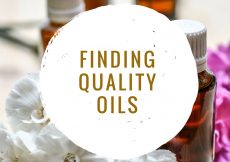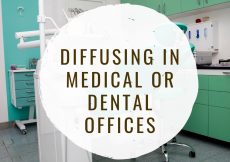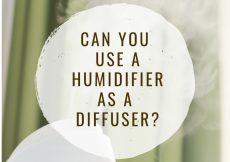This post may contain affiliate links. If you make a purchase, I may earn a commission. As an Amazon Associate, I may earn from qualifying purchases.
Every winter there is a range of nasties that make the rounds, from annoying colds to debilitating flus, to miserable gastorenteritis. Sickness is not fun. This winter, a few school districts around my area have had absenteeism up to 40% with norovirus. It can be easy to see why teachers may want to run a diffuser in the classroom. Many essential oils are antiseptic, antibacterial, and antiviral—some of them powerfully so. It sounds like a good idea on the surface, but with a little research, we can see it is not so simple.
In this article, we will examine the common reasons why teachers diffuse in the classroom, what popular oils may be involved, and the safety of those oils. Then, we will talk about the general safety and legal concerns of diffusing in public places around other people’s children.
Diffusing Essential Oils for Germbusting:
While a wide variety of oils can be used to help with germs, often blends with powerful oils such as cinnamon, clove bud, eucalyptus, rosemary or peppermint are used. The idea is that diffusing such essential oils will not only make it into the blood streams of the people in the room—thus working on preventing illness on the individual level—but also cleanse the air and room surfaces of germs.
We have scientific evidence that such a reduction in germs can occur with diffusion (one such study). I use diffusion for this purpose in my home. But, when my children were younger (I started diffusing when my youngest was 7) I was careful to diffuse while they were at school, or after they went to bed in another part of the home. The very low levels of residual oils lingering in the air gave them some protection without being excessive.
Let’s examine the safety of some of the popular oils in anti-germ blends
Cinnamon oils (bark and leaf) are high in eugenol. You should avoid bark oil with diabetes, bleeding disorders, anticoagulants medications, surgery, and peptic ulcers; Leaf oil may interact with MAOI medications, SSRI medications, anticoagulant medications, and with bleeding disorders, surgery, and peptic ulcers.Oils high in eugenol can interfere with clotting. Do not diffuse around babies under 6 months.
Clove Bud oil is also high in eugenol (75%), so many of the same precautions apply, in particular in relation to blood clotting. Both cinnamon and clove can cause sensitivity reactions. Do not diffuse clove bud around children under 2. (Do not use clove leaf at all).
Eucalyptus is high in 1-8 cineole. According to Tisserand and Young, in Australia eucalyptus oil is classified as a Schedule 6 poison, which is the lowest level of poison. The oil can be neurotoxic and symptoms would include rapid onset of drowsiness followed by possible nausea and loss of consciousness. Children require a lower dose to get to this state and there are documented cases of such reactions, including one that led to grand mal seizure. Do not diffuse around children under 10.
Rosemary This oil has various chemotypes, some of which are high in 1-8 cineole. Rosemary contains camphor which can be neurotoxic. It should not be applied to or near the face of infants or children. Do not diffuse around children under 10.
Peppermint should not be used with cardiac fibrillation or G6PD defiency. It can be neurotoxic and a mucous membrane irritant. Use on or near face of infants and young children can cause respiratory difficulties. Do not diffuse around children under 6.
Diffusing Essential Oils for Concentration and Focus:
Some of the best oils to diffuse for concentration include Basil, Peppermint, Rosemary, and Black pepper
We have already looked at the safety of Peppermint and Rosemary.
Black Pepper is generally safe, but old oils may become oxidized and cause skin sensitization. Do not diffuse around children under 2.
Basil has several chemotypes so it is important to know which basil is being used. Some possible safety concerns include some chemotypes are potentially carcinogenic, might interfere with blood clotting, or possibly cause skin sensitization. Do not diffuse around children under 2.
Diffusing Essential Oils for ADHD:
Here is the obvious problem with diffusing in the classroom to address ADHD—not everyone in the class will have it. You will be treating children who don’t need to be treated. Common sense tells us that using a treatment for a condition we don’t have is not wise.
Lavender: Do not use around babies under 3 months. Generally safe though sensitization is possible.
Cedarwood: Do not use around babies under 6 months. There are a variety of Cedarwoods available (Atlas, Himalayan, Texan, etc), some of which are actually from the Juniper family. It is recommended to check which type of Cedarwood you have by botanical name.
Frankincense: Improper storage can lead to oxidation. Oxidized oils can cause skin sensitivity. Do not use around children under 2
Vetiver : Do not use around children under 2.
(Oils for ADHD from: Source http://www.altmd.com/Articles/Aromatherapy-Essential-Oils-for-ADHD)
Diffusing to Calm the Class:
I teach adults, and sometimes it can hard to get them to settle down and pay attention, so I can’t imagine what elementary and middle school teachers go through! Two of the most popular oils for calm are also two of the gentlest and are on the very short list of oils safe for babies. Despite this,
Chamomile: Do not use on babies under 3 months. While chamomile is generally considered safe, some think that it may cause reactions in people allergic to ragweed, marigolds, daisies, and other related flowers (Source)
Lavender: Do not use on babies under 3 months
The above safety data was largely sourced from Tisserand & Young’s Essential Oil Safety 2nd ed (affiliate link, Amazon). This is an excellent reference for safety information and highly recommended for anyone serious about using essential oils (warning—it is not light reading).
The Dangers of Diffusing Essential Oils:
I want to begin this section by clearing up a couple myths:
1) The safety recommendations for essential oils that I have been discussing apply to ALL essential oils (ALL brands). It does not matter if the oil is certified pure, therapeutic, organic, or blessed by the pope. Do not let anyone tell you that certain brands of oil are more pure and therefore the safety rules don’t apply.
2) Having a negative reaction to an essential oil such as a rash is not your body detoxing. Rashes=your body doesn’t like or want whatever you put on it. It’s telling you, “hey, don’t do that again.”
As you can see from the safety information discussed above, there are potential health concerns with diffusing oils when children are in the classroom (and even more so for daycares where younger children are). A child could have a negative reaction to an oil. They could have a condition, disease, or be taking a medication that is contraindicated for certain oils.There is also a chance of developing a sensitization reaction. This is an allergic reaction that can cause itching, redness, rash and welts (Source)
There are other reactions that people can have that are not true allergies, but still negative. We are all individuals and react in different ways to the same substance. For example, I may be able to take Penicillin while it makes you nauseous. You are not allergic—but nonetheless your body reacts with feelings of nausea.
Dosages also make a difference. Two people can react very differently to the same dose of caffeine. For one, their heart may race and their hands shake while the other is fine. Prolonged use of essential oils can cause symptoms such as vertigo, lethargy, headaches, nausea, and dizziness (Source). Children have smaller bodies than adults and can reach this “overdose” sooner.
Read more: Diffusing around children
The legal aspects of diffusing in the classroom:
Aside from health dangers, there are legal issues to consider. Schools often don’t allow children to have medication with them, and schools require a note from the child’s doctor before they will administer medications to children. While legally essential oils are not considered medicine, they can be therapeutically active and as such, children should not be exposed to them without express written consent of their parent or legal guardian. Failing to do so can open up a heap of legal trouble should someone experience a negative reaction or interaction.
In some school districts, policies on essential oils are being instituted and I expect this will spread. This article details how one district restricted oils due to other children in the classroom having asthma or allergic reactions to their classmates using oils.
Finally, many school campuses have no fragrance policies. While some people with fragrance sensitivities may find that they are able to tolerate natural fragrances, by the letter of the law, essential oils contain aromatic molecules and thus are a fragrance.
What is the best way to use essential oils in the classroom?
First, let’s talk about how to safely diffuse essential oils around children in general (your children or those you have permission to diffuse around). There are two main things to remember:
1) Diffuse oils that are safe for your child’s age and health status
2) Diffuse for no more than 30 minutes at a time (and if using a nebulizer, less than 10 minutes at a time)
Safety expert Robert Tisserand recommends very low levels of diffusion around children. He also suggests that rather than continuously trying to protect children with essential oils, that aromatherapy be used on an as needed basis. (Source). This includes when someone is sick or has been exposed to someone who is sick.
If you are a teacher, keeping a personal inhaler in your desk is the best option. This way you can use oils that are appropriate for you and not have to worry about the health concerns of others. An even better option is to have a car diffuser and use it on your commute to and from work. You get the benefits right before and right after being around your pupils but leave the oils outside of the building. I would not recommend aromatherapy jewelry as at some point in the day you will be interacting closely with your students.
If you want to diffuse essential oils to cleanse the air of germs, with permission of your administration, I would diffuse the oils at the end of the day after the children have all gone home. You can disinfect both the air and the surfaces of the room by doing so, and by the time children return, nearly 18 hours will have passed and the oils will have dissipated. It is not necessary to use powerful anti-germ blends for daily use. Lemon oil works well, or use lemongrass and geranium like in the study referenced above. Save the anti-germ blends for those times when sickness is particularly rampant.
If you want to use the oils for other reasons such as calming or concentration, you should seek alternate methods.
Hopefully this clears up the confusion on diffusing oils at school. If you are a teacher, I hope you will heed the advice in this article. If you are a parent and see diffusion happening in the school, make your case to the person in question, or bring it to their superiors. Our little ones best interests are at stake.



